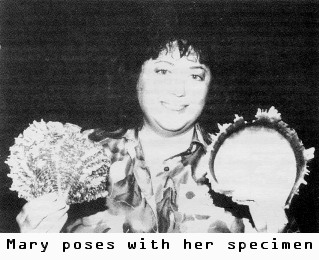|
Pinctada margaritifera (Linnaeus, 1758) |
|
an invasive species from the Indo-Pacific | internal and external view of right valve |
|
|
|
Off Boynton Beach, Palm Beach County, Florida |
Expect The Unexpected |
|
By Bill Frank |
|
Regardless of our varied stated reason for going shelling, deep down inside most of us share a common desire to find something truly unusual. It might be a world record size specimen, a sinistral two foot long Horse Conch, or maybe the discovery of a new species which is subsequently named in our honor. Occasionally something unusual is found but over a year elapses before the significance of the find comes to light.
Mary knew she had collected something special but the exact identification of the find remained elusive despite assistance from fellow club members. Opinions ranged from a mutated Spondylus to a pearl oyster. Upon hearing the latter, a search for a pearl was made with disappointing results. Recently at he Shellers' Jamboree in Largo, Florida identification confirmed the rarity of the find. Mary had collected a Pinctada margaritifera (Linnaeus, 1758), and a large specimen at that. This species is normally found throughout the Indo-Pacific Region. So how did a shell from the Pacific Ocean come to be found off Boynton Beach. As with previous introduced molluscs, it could have either been attached to a ships hull or been present in the ballast water carried by a ship transiting from the Pacific. To combat this sort of inadvertent species introduction, ships have been encouraged to exchange ballast water while on the high seas. Too often in the past, introduced species have proven either destructive to local fauna, a nuisance, or a costly menace as in the case of several species of mussels (see: "Immigrant Mussel Settles In Northside Generator"). In this particular case, it appears that no harm to the local environment will take place and Mary has thus far been unable to locate additional specimens during subsequent dives. However, this event does make one wonder though what other Pacific species could be present off the Florida Coast, especially near the many busy ports such as Jacksonville. Editor's Note (2003): Since Mary's initial find, at least three additional specimens of Pinctada margaritifera have been found off the south Florida coast by John Chesler (Plantation, FL), Tom Honker (Delray Beach, FL), as well as Mary. It should be noted that the specimen found by Mary was initially thought to be Pinctada mazantlanica (Hanley, 1856) - another Indo-Pacific species. However, during September of 1993Dr. Paula Mikkelsen of the American Museum of Natural History positively identified the specimen as Pinctada margaritifera. Also see: http://www.jaxshells.org/pdfs/julaug93.pdf (page three) |

 Such is the case with Mary Bukstel of Boca Raton, Florida; a member of the
Broward Shell Club. Approximately a year and a half ago Mary, a diver and
Spondylus/Chama collector, was at a depth of 90 feet off Boynton
Beach searching the backside of the reef. While in the spur and groove reef
formation, a movement caught Mary's eye as a large bivalve closed at her
approach. There half on the reef and half on the sand was a large specimen which
she collected with some difficulty.
Such is the case with Mary Bukstel of Boca Raton, Florida; a member of the
Broward Shell Club. Approximately a year and a half ago Mary, a diver and
Spondylus/Chama collector, was at a depth of 90 feet off Boynton
Beach searching the backside of the reef. While in the spur and groove reef
formation, a movement caught Mary's eye as a large bivalve closed at her
approach. There half on the reef and half on the sand was a large specimen which
she collected with some difficulty.